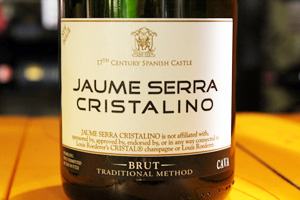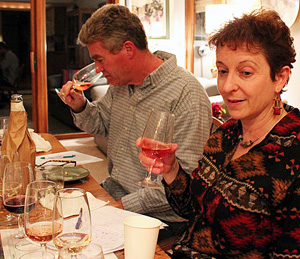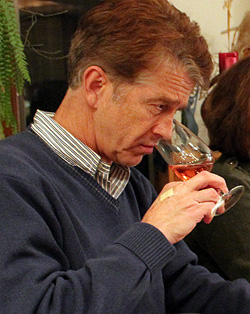Column: Arbor Vinous
Ricky (walks in the front door): Lucy, I’m home!
Lucy (runs up and plants a smooch): Ooh, hi honey!
Ricky: Tonight we celebrate the band’s big record deal! Did you remember to buy the Cristal Champagne?
Lucy: Oh, Ricky, you’re going to be so proud of me!
Ricky: And why is that?
Lucy: Remember you told me that Cristal costs $250?
Ricky (suspiciously): Yes?
Lucy (pulls bottle from behind back): Look! I found a bottle for just $8!
Ricky (visibly upset): Lucy, that’s not Cristal. It’s not Champagne, it’s cheap Cava from Spain. See, it says “Cristalino”! That means “little crystal.”
Lucy: Oh, that’s OK. I’m just going to drink one glass.
Funny? Maybe not so much. Especially if you’re the maker of the sparkling wine formerly known as Cristalino, a Vinous Posse top value pick in the last two December budget bubbly shoot-outs.
Howcum? Back in 2006, Louis Roederer, producer of Champagne-to-the-rap-stars Cristal, found fault with the similarity in name and foil labels of the decidedly down-market Spanish Cava.
Next step: Federal court, for a lawsuit against Cristalino’s owners for trademark infringement.
Roederer’s legal eagles probably figured they couldn’t pass the smirk test with a claim that consumers would confuse the $8 and $250 bubblies. Instead, their court brief accused Cristalino of trying to hoodwink a gullible public into believing that the “inexpensive sparkling wine is the low-priced offering of the makers of the premier champagne, Cristal.”
Roederer also argued that even those who weren’t fooled might “associate the famous brand Cristal with Cristalino sparkling wine, thereby weakening the distinctiveness of the famous brand.”
(I admit to a fly-on-the-wall frisson watching French and Spanish wineries pay U.S. lawyers to duke it out for four years, with a side-trip to the Court of Appeals. Kind of like a grown-up version of the hoary schoolyard classic, “Let’s you and him fight.” Or Lisa Murkowski playing smackdown-in-the-tundra with Joe Miller and Sarah Palin.)
Over the summer Minneapolis-based federal judge Joan Ericksen finished riddling the evidence and disgorged her ruling. It left the Spaniards dripping with spray.
In what has to be called a name-changer, Judge Ericksen ordered Cristalino to eliminate any reference “likely to cause confusion, mistake or deception with Roederer’s Cristal marks.” The court-mandated extreme makeover included the bottle’s label colors and fonts, along with the name of the wine itself.
Now rebranded as “Jaume Serra Cristalino,” the bottle sports a new, cream-and-black label that’s currently finding its way onto Ann Arbor retail shelves as stores sell through their old stock. And at the bottom, in agate type, you’ll find a Burlington Coat Factory-style disclaimer:
JAUME SERRA CRISTALINO is not affiliated with, sponsored by, approved by, endorsed by, or in any way connected to Louis Roederer’s CRISTAL® champagne or Louis Roederer.
Is that Cristal-clear?
What’s To Drink?
If your budgetary compass points closer to Cristalino than Cristal this holiday season, then descend into the effervescent demi-monde of under-$25 sparkling wines. For our annual shoot-out, the Vinous Posse blind-tasted 16 bottles from Australia, France, Germany, Italy, Spain, California and Michigan.
We felt tempted – but successfully resisted – inserting Four Loko as a ringer. But after its early November Michigan prohibition and subsequent reformulation sans caffeine, you may want to bookmark this eye-opening recipe (complete with instructional video and blind taste test) to concoct your own version at home. Don’t forget to buy the Jolly Ranchers.
Odd moment of the month: not swinging by South U to collect a couple of bottles from Village Corner. I can’t add much to everything that out-of-towners, long-timers, former and current University of Michigan students wrote about the store’s hiatus, except to number myself among the Ann Arbor wine-buyers who, over a period of four decades, came to see Dick Scheer and his long-tenured staff as the area’s go-to-guys (never a woman!) for a healthy pour of wine savvy along with that bottle or case.
(In the midst of the adulatory press coverage, Scheer became miffed over a misquote in December’s Ann Arbor Observer, which said he would relocate the store “sometime in 2012.” In an email sent to some of his customers, he wrote: “I have never said such to any interviewer. I intend to reopen Village Corner in a matter of weeks, not months or years.”)
Across town, VC alumnus Jorge Lopez-Chavez has already settled into new digs at the Produce Station, where he’s currently re-energizing the wine department. Once the new boss – very different from the old boss – departed earshot, Lopez-Chavez confided that he’d set all things fermented ship-shape on South State in short order.
With VC on injured reserve, this year’s roster of bubbly purveyors included the Produce Station and two wine specialists: A&L Wine Castle, along the competitive Stadium/Maple corridor, and the recently expanded (to excellent effect) Wine Seller, in Plymouth Road Mall.
We tasted and rated the wines blind, on a scale from ![]()
![]()
![]()
![]()
![]() (“Only mix with orange juice”) to
(“Only mix with orange juice”) to ![]()
![]()
![]()
![]()
![]() (“So who needs Cristal?”). The Posse doesn’t practice grade inflation, so the mid-tier wines are worth your consideration.
(“So who needs Cristal?”). The Posse doesn’t practice grade inflation, so the mid-tier wines are worth your consideration.
For a guide to the variety of words and styles you’ll find on and inside bottles of sparkling wine, visit the December, 2008, shoot-out. Since sparkling wine styles vary greatly, also take a look at the notes along with the ratings – they’ll help you pick a bottle to suit your taste or food pairing. Unless otherwise mentioned, all have brut (that’s real dry) levels of sweetness.
Recommendations
Two bottles stood out at Posse Central: a seldom-seen German Riesling Sekt that just snuck under the price cap, and one from southern France that claims to be the world’s oldest sparkling wine.
High-quality Sekt is a Germany’s answer to Champagne – a bottle-fermented sparkler that’s not typically aged as long as in France. One great place to learn about Sekt’s appeal is from the 2008 VON BUHL Riesling Sekt b.A. Brut ($24 at Everyday Wines). Estate-grown from a 150-year-old producer, this wine is a crisp, fresh sparkler that’ll put a tingle in your mouth as it complements hors d’oeuvres and lighter dishes.
Want to pour a toast for a crowd? Try the pleasantly Champagne-like 2006 SAINT-HILAIRE Brut Blanquette de Limoux. Our sample came from Wine Seller, where it sets you back $14, but, as of Dec. 1, Costco had cases of the stuff piled in the center aisle for $10. As with most items Costco-esque, your findings may vary.
The first written record of Saint-Hilaire bubbled up in 1531, predating Champagne by more than a century. As the story goes, Benedictine monk Dom Perignon purloined the Limoux formula for sparkling wine while passing through the Languedoc en route from Spain back to his monastery in Champagne. The rest, as they say, is history. Or good marketing.
Are you a locapour? The 2008 BLACK STAR FARMS Brut Sparkling Wine, Michigan’s 2010 trophy-winner, showed competently against the global competition. Despite its in-state origin, it’s the only wine we tasted that’s unavailable to buy locally – you’ll have to order it from the winery ($22.50 plus shipping).
Also worth a mention are some picks from Decembers past: CA’ DI PIETRA Pinot Prosecco, MONTESSEL “Vigna del Paradiso” Prosecco Extra Dry, and ROEDERER ESTATE Brut, along with those relabeled Top Values from Spain, JAUME SERRA CRISTALINO Cava Brut, in both its white and rosé variants.
Ratings
![]()
![]()
![]()
![]()
![]()
VON BUHL 2008 Riesling Sekt Brut, Rheinpfalz, Germany (Everyday Wines, $24). A wine that appealed across the board. On the tart side, showing off its cool-climate growing region with a crisp but elegant higher-acid, lemon-inflected flavor profile. “Fantastic for a romantic interlude in front of the fire,” opined one Posse member.
SAINT-HILAIRE 2006 Brut Blanquette de Limoux (Wine Seller, $14; find it for sale at Costco for $10 and it’s a TOP VALUE). Nearly-consistent high scores, Champagne-like in style, a lightly toasty aroma with some yeasty notes of fresh-baked bread, a well-balanced body and pinpoint bubbles. Just slightly frothy.
![]()
![]()
![]()
![]()
DOMAINE CHANDON Rosé, California (Plum Market, $12). For years, I consigned Chandon’s California bubblies to my “second-rate” mental bin, until a recent Jon Bonné column in the San Francisco Chronicle encouraged this revisit. Pale, almost onion-skin pink, doughy/toasty aromas, gentle cherry flavor and medium-weight, though not overly complex. A hint of sweetness on the finish. Serve it with salmon.
HENRY-DETALY Brut Champagne, France (Trader Joe’s, $19). Unsubtle but not unsatisfying – unsurprising for authentic Champagne in this price range. Big-boned and slightly sour, it’s short on fruit but compensates with healthy wallops of biscuit, yeast and toast. “In your face!” said one taster – and most others agreed.
KIRKLAND Brut Sparkling Wine, Sonoma (Costco, $11). TOP VALUE! Last year, Costco dropped the price of its authentic Champagne to $20. This year, they introduced this even-cheaper Californian. Just the thing if you like a fuller-bodied sparkler with up-front fruit, a soft, round mouthfeel, slight earthiness and gentle acidity. “Tastes like Chandon,” said one Posse member.
LIOPART Brut Rosé Cava Reserva, Spain (Produce Station, $20). Salmon-colored with bright, fresh watermelon and strawberry flavors, and a round mouthfeel. Several folks thought it was New World, not European. Good choice if you’d like to serve bubbly alongside heartier foods.
![]()
![]()
![]()
BLACK STAR FARMS 2008 Brut Sparkling Wine, Leelanau Peninsula, Michigan (Black Star Farms winery, $22.50). This one’s a cheat – you have to contact the winery to buy it. Fresh apples, slightly herbaceous and just a little off-dry. Excellent with food.
JEAN-LOUIS DENOIS Chardonnay Blanc de Blancs, France (Plum Market, $16). The go-to wine from Plum’s Rod Johnson for those who like Champagne’s style, but not price tag. Strong consensus among the tasters – three stars from everyone. Classically-styled French – some citrus, some yeast, some toast.
POULET & FILS Clairette de Die, France (Arbor Farms, $16). A blast of grapefruit and passion fruit on the nose, followed up by – lots more fruit! Enjoyably casual with lots of sweetness but little structure. Posse members let fly with descriptions: “Fruit cocktail.” “Cornucopia of candied fruit.” “Va-va-voom!” You get the picture.
![]()
![]()
![]()
CHAMPALOU Brut, Vouvray, France (Morgan & York, $22). The only wine in the tasting made from Chenin Blanc, it’s bone dry with some pine/evergreen/wintergreen notes on the pleasantly rounded palate. Short finish.
J.P. CHENET Blanc de Blancs, France (Whole Foods, $12). Light and fruity, with a great apple nose. Would have rated higher except for some background chemical notes to burst its bubble, reminding one taster of lemon furniture polish, another of Pine-Sol.
FERRARI Brut, Trento, Italy (A&L Wine Castle, $20). Mushrooms, toast and hazelnut abound in this bone-dry all-Chardonnay sparkler. One taster likened it to Frangelico; “We got da funk!” said another. Look elsewhere if you prefer fruit or subtlety.
DOMAINE THIBERT Cremant de Bourgogne, France (Arbor Farms, $20). Bright, light and tangy, with pear/apple aromas and an abundance of fizz. Pleasantly enjoyable, without a lot of depth.
THORNE CLARKE Brut Reserve, South Australia (Whole Foods, $16). Mid-bronze colored blend of Pinot Noir and Chardonnay. Slightly sour, full-bodied, and one-dimensional, several folks felt that it looked and tasted older and a little tired.
![]()
![]()
LOUISE D’ESTRÉE Sparkling Dry Red, France (Trader Joe’s, $7). I’m a sucker for sparkling reds – but even for seven bucks at TJ’s, you might do better. A simple, off-dry quaffer with deep ruby color and less-than-ripe herbal flavors. Several folks found it “cardboardy” (but not corked). Think of it as the “Beaujolais Nouveau of bubblies” and “take it out cross-country skiing.”
![]()
![]()
LABRUSCA Lambrusco Bianco, Emilia, Italy (Everyday Wines, $16). An unusual but disappointing off-dry bubbly Lambrusco that earned consistently low scores for its chemical/acetic acid aroma and flavor, along with a bitter finish.
***** ***** *****
Quote of the Month
“Old World wines ask you to dance with them; New World wines push you prone onto a chair and give you a lap dance, no touching.” – German importer Terry Thiese, in my new-favorite wine world memoir, “Reading Between The Wines.”
About the author: Joel Goldberg, an Ann Arbor area resident, edits the MichWine website and tweets @MichWine. His Arbor Vinous column for The Chronicle is published on the first Saturday of the month.








